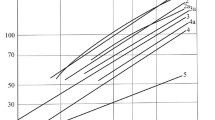Numerical simulation of velocity and temperature fields with laminar liquid flow in a laboratory experimental loop thermosiphon (natural circulation loop) has been made. A vertical electrically heated pipe served as a lift section. Calculations were carried out for the case of heating the entire length of the pipe under conditions of constant heat flux density on the wall. The construction of the loop is considered, in which local pressure losses and friction losses of pressure in the descending pipe are negligibly small in comparison with friction losses of pressure in the ascending section.
The object of the analysis is the laminar mode of flow. In this regime, in the flows originating exclusively under the action of thermogravitational forces, the skin-friction coefficient varies in the most sophisticated way along the flow. Using the results of calculation of velocity and temperature fields, the longitudinal changes of the skin-friction coefficients and of heat transfer coefficients are determined. As a whole, according to the results of 2D numerical simulation, the skin-friction coefficients depend in the main on the change of the velocity gradient on the wall along the flow as a result of practically continuous rearrangement of velocity profile along the entire heating zone. The form of the velocity profiles and the degree of their deformation depend in turn on the heat flow density on the wall and on the hydraulic diameter. It is shown that in a single-phase loop of natural circulation (i.e., under conditions where the liquid moves exclusively under the action of thermogravitational forces) the shear stresses on the wall change along the heating zone in a complex way, and the skin-friction coefficient cannot be described by the simple dependence of the form ξ = a/Reb for being used in one-dimensional calculations. In all of the calculated regimes, including the one with the least (of those considered) heat flux density on the wall, the Nusselt numbers exceeded the stabilized values under the conditions of forced flow with constant thermophysical properties. With increase in distance from the entrance into the zone of heating, the Nusselt numbers first decrease monotonically, attain minimum values, and then begin to increase.
Similar content being viewed by others
References
Y. Zvirin, A review of natural circulation loops in pressurized water reactors and other systems, Nucl. Eng. Des., 67, 203–225 (1981).
N. Kumar, A. K. Nayak, P. K. Vijayan, and K. K. Vaze, Modeling the flow characteristics during start-up of natural circulation systems from rest state, Reactor Engineering Division Research Article, Issue No. 336, January–February 2014, 1–11 (2014).
N. Kumar, J. B. Doshi, and P. K. Vijayan, Investigations on the role of mixed convection and wall friction factor in single-phase natural circulation loop dynamics, Ann. Nucl. Energy, 38, 2247−270 (2011).
S. Mousavian, M. Misale, F. D′Auria, and M. A. Salehi, Transient and stability analysis in single-phase natural circulation, Ann. Nucl. Energy, 31, 1177−1198 (2004).
M. Misale, P. Garibaldi, J. C. Passos, and G. G. de Bitencourt, Experiments in a single-phase natural circulation miniloop, Exp. Therm. Fluid Sci., 31, 1110−1120 (2007).
O. N. Kaban’kov, N. O. Zubov, L. A. Sukomel, and V. V. Yagov, Investigation of flow characteristics and heat exchange during liquid boiling in the natural circulation loop, in: Problems of Gas Dynamics and of Heat and Mass Transfer in Power Engineering Installations, Proc. School-Seminar of Young Scientists and Specialists under supervision of Academician A. I. Leontiev, 24–29 May 2015, the city of Zvenigorod, Izd. Dom MEI, Moscow (2015), pp. 311–314.
O. N. Kaban’kov, L. A. Sukomel, V. V. Yagov, and N. O. Zubov, Unstable circulation regimes during water boiling in a thermosiphon loop under atmospheric pressure, Heat Pipe Sci. Technol., 7, Issues 1−2, 31–44 (2016).
V. V. Yagov, Heat Transfer in Single-Phase Media and at Phase Transformations, Textbook [in Russian], MÉI, Moscow (2014).
B. S. Petukhov, L. G. Genin, S. A. Kovalev, and S. L. Solov’ev, Heat Transfer in Single-Phase Media and Phase Transformations, Textbook [in Russian], MÉI, Moscow (2003).
B. S. Petukhov, Selected Works. Heat Transfer Problems [in Russian], Nauka, Moscow (1987).
B. Gebhart, Y. Jaluria, R. L. Mahajan, and B. Sammaki, Buoyancy-Induced Flows and Transport [Russian translation], in two books, Mir, Moscow (1991).
V. I. Artemov and G. G. Yan’kov, Numerical analysis of the efficiency of operation of sectioned conditioner with an air heat exchanger, Vestn. Moskovsk. Énerg. Inst., No. 6, 155−160 (2010).
Author information
Authors and Affiliations
Corresponding author
Additional information
Translated from Inzhenerno-Fizicheskii Zhurnal, Vol. 93, No. 5, pp. 1319–1329, September–October, 2020.
Rights and permissions
About this article
Cite this article
Sukomel, L.A., Kaban’kov, O.N. & Ankudinov, V.B. Numerical Simulation of Friction and Heat Exchange in Viscous-Gravitational Fluid Flow in a Loop Thermosiphon. J Eng Phys Thermophy 93, 1275–1284 (2020). https://doi.org/10.1007/s10891-020-02232-2
Received:
Published:
Issue Date:
DOI: https://doi.org/10.1007/s10891-020-02232-2



